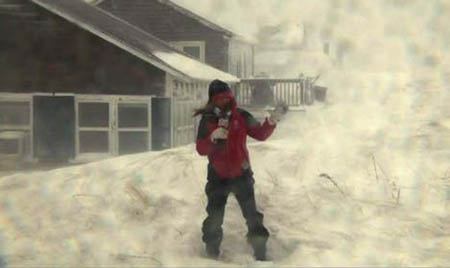Boston’s WCVB Weathers Record-Setting Winter
BOSTON—When will the snow stop falling? That’s the question that Boston TV broadcasters are asking themselves, as the city continues to dig out from one blizzard after another. The ongoing accumulation of snow has become so severe that it has packed city streets and crippled public transit.

WCVB Meteorologist Danielle Vollmar in the middle of one of several blizzards to hit Boston last month. In the midst of it all, local TV news departments have been working overtime to keep viewers informed. “We’ve been running 12-hour shifts,” said Andrew Vrees, WCVB-TV’s news director. “We’ve also done wall-to-wall coverage every time a major new storm comes in—and they keep coming.”
WCVB has been using a mix of satellite/microwave trucks and wearable TVU transmitter packs to cover the snow story. “It depends on what we’re up against: If there’s no place to park the trucks, then we send out crews with TVUs,” Vrees said. “But when the wind gets whipping 50-60 mph and there’s no cell service available, then we send out the trucks to weather the blizzards.”
Boston TV news crews have been able to move around Massachusetts even during times when the public has been told not to drive, thanks to an exemption from the state government. But there are only so many people to cover the story, in a state “with lots of affected areas and an extensive coastline,” said Vrees. “This is why we are supplementing our own materials with viewer-contributed video and stills. The public has helped us expand our coverage, which is a big help.”
Despite the snow onslaught, WCVB has not suffered any serious downtime. “The power has stayed on despite the storms, and if it fails, we do have backup generators; after all, we do live with snow each year,” Vrees said. “The tough part is this story just won’t end, which is hard on our staff. Keeping their spirits up is our biggest challenge, simply because this natural disaster keeps going. We do have dedicated, awesome people on staff, but really, enough is enough!”
Meanwhile, Boston’s snow story keeps evolving. What started as a conventional short-term “snowpocalypse” event has now become a marathon, with unfamiliar issues such as roof collapses and infrastructure failures coming to the fore. “We had one case of tons of snow falling off a roof in Cambridge: It was like an avalanche,” said Vrees. “There was at least one person buried. Fortunately she got out okay.”
The only good news for Boston broadcasters is that spring will inevitably arrive. “We know there is light at the end of the tunnel,” said Vrees. “But rising temperatures will create their own issues, such as flooding when the snow finally does melt.
The professional video industry's #1 source for news, trends and product and tech information. Sign up below.
“It seems as if Boston’s TV news departments can’t get away from the center of the news cycle,” he added. “First there was the Boston Marathon bombing, then the hurricane—and now this.”
James Careless is an award-winning journalist who has written for TV Technology since the 1990s. He has covered HDTV from the days of the six competing HDTV formats that led to the 1993 Grand Alliance, and onwards through ATSC 3.0 and OTT. He also writes for Radio World, along with other publications in aerospace, defense, public safety, streaming media, plus the amusement park industry for something different.

